41 Years Delayed
In 1968 a pair of newlyweds (us) took a honeymoon through most of the great National Parks of the Northwest. On the way to Banff and Jasper in Canada, we arrived at the eastern entrance to Glacier National Park only to find the famous Going to the Sun Road buried under snow.
How circumstances change! Now our younger daughter is enrolled in the pre-vet program at the University of Idaho in Moscow. Of course we wanted to see what that was like, and since we now have Lifetime Senior Passes to the National Parks, why not finally see that Park while we were in that neck of the woods?
To visit her though, we’d have to board Rosebud, our 74 pound rescue “Lab mix” (she was found abandoned so her actual lineage is unknown), and with abandonment issues and an unresolved tummy issue, that was not an option. Besides, our daughter misses her!
So what’s a muthah to do? Why, rent a motor home of course!
Five and a Half Tons
Since 1966, the name “Winnebago” has been nearly synonymous with a rolling mini-home. Today, they account for perhaps 43% of the RV market. If we rented one of those we could take Rosie along. It’s only about double what you’d pay to have your dog boarded, drive your nice sweet-handling high mileage personal car and stay in comfortable motels for twelve nights.
So the decision for anyone in bondage to a beloved pet is a no-brainer, right?
What Have We Got Ourselves Into?
Anyone with an ounce of automotive passion will know without being told that this is not driving for pleasure.
The 2018 Minnie Winnie we rented was built on a Ford E350 truck chassis. GVW (Gross Vehicle Weight rating) is about 11,000 pounds. Even lightly loaded like ours, that means all the springs and dampers are designed to support that much. In short, it drives and rides like what it is, a truck. We would not be carving apexes, late braking, and building lateral gs on twisty mountain roads.
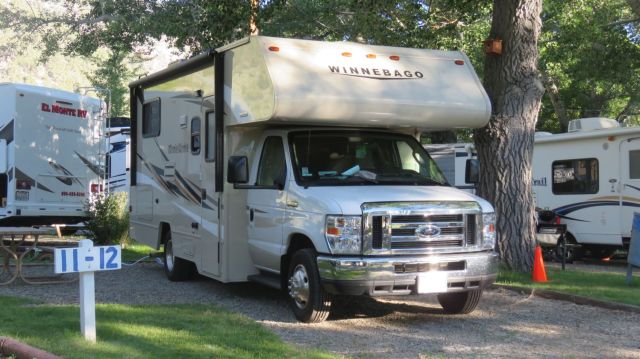
“Our” Minnie Winnie, Mono Vista RV Park, Lee Vining July 1, 2019.
A typical sedan or SUV today doesn’t have a big-block V8, so it’s quite a step to Ford’s three-valve Triton® V10: 6.8 liters (415 cubic inches), developing a mere 305 horsepower at a moderate 4,250 rpm, but a more important 420 pound-feet of torque at 3,250 rpm. We needed every one of both, and a transmission willing to downshift climbing passes as high as 8,735 feet.
With a creaky RV cabin mounted on that chassis, it makes for a rough, noisy ride. We were never tempted to test the sound system.
RV Park Living
When I was a kid, our cabin cruiser was optimistically rated for sleeping six, but was tight for Mom and Dad and three kids. Our 24’ Minnie Winnie was also a “six-sleeper.” Maybe – if they packed like a backpacker, and those people were very friendly. We maxed out every storage space with clothes and provisions for two plus Rosie, and we grocery shopped and made use of laundry facilities on the trip.
Then there are the details of living with an RV. Taking full advantage of the capabilities of the vehicle, one could “dry camp.” That means pulling over at a convenient spot (where legal), powering up the generator, and being self-sufficient wherever you alight. But generators are noisy, and security anxiety makes a dedicated RV park more attractive. You plug into their electricity and water supply, which are covered by the space rental, at a cost about a quarter to a third of what you’d pay for a motel stay.

Many sites have 80PSI water connections that require a pressure reducer (the brass fitting on the hose). It had us flummoxed until a friendly camper (most are) demonstrated that the whole head slides up the pipe to open.
On the road you have the advantage of skipping many rest stops with your built-in bathroom, although the driver still needs to take occasional breaks. Also, you need not rely on the hygiene of the RV camp showers, although if you are a large person, you may find the one in the vehicle a bit tight.
The other side of that advantage is the dreaded Dump. Our background is in architecture so the workings of a plumbing system are not foreign to us, but this is – quite literally – hands-on stuff. In your home plumbing, every drain goes into the same pipe eventually. An RV is the same, but you are the one who combines the icky stuff (called “black water”) with the more innocuous dishwater and shower discharge (gray water). It’s all held in separate tanks until you dump it.
A note to guys: In an RV the only thing you do in the shower is shower.
At every site, the RV’s waste water discharge has to be connected to the park’s sewage system. You either attach your RV to it at the pad or do it on your way out at a community dump station.
You pack disposable gloves, and wear them as you attach the flexible line (provided) from the RV’s discharge port to the sewer inlet, and separately “dump” the black and gray water (in that order, to flush the line) once a day. You open and shut off the discharges in order, disconnect the dump line, flush it thoroughly with clean water, collapse the line (It accordions into a remarkably compact coil.), and store it for the next dump.
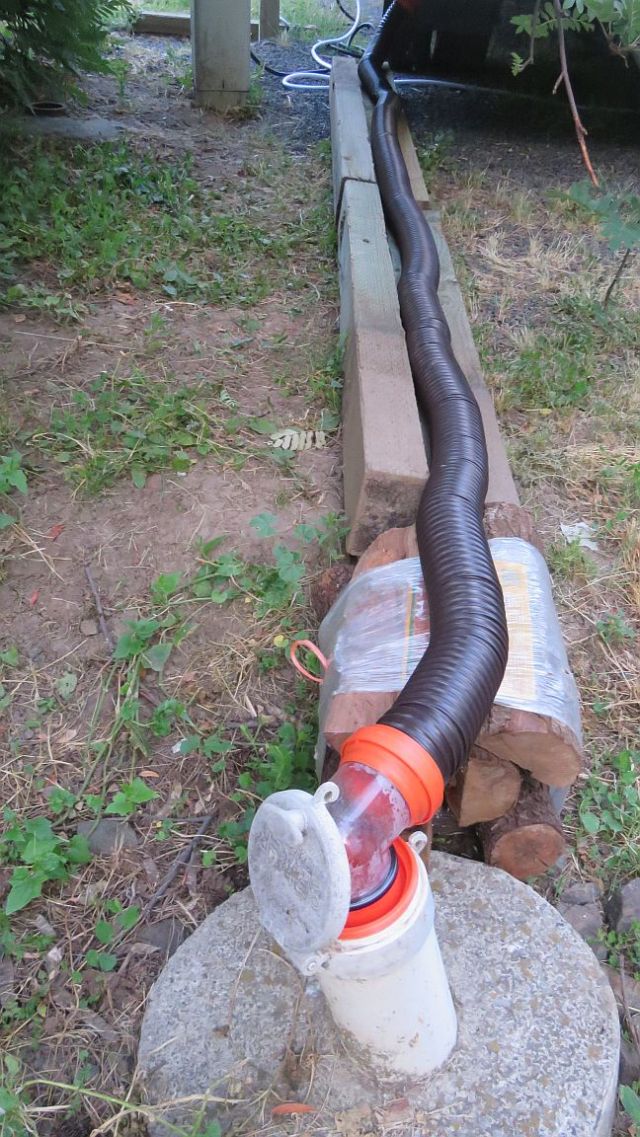
Camping in an RV, you have to be your own Ed Norton (Art Carney in The Honeymooners.). Gravity is your friend.
Plan Ahead – Way Ahead
Our nominal two-week trip bracketed the Fourth of July Holiday. As you can imagine, everyone in the US is vacationing around then. We began reserving both the RV and places at all the stops we’d be making back in late April. That was a challenge, researching the route, keeping each day’s drive within a reasonable range, and finding an available site at an RV Park that looked attractive, near the planned route.
The Rental
The easy and cheap way to rent an RV is to go to Cruise America® and rent an RV similar to ours, but emblazoned with graphics advertising to the world that it’s rented. When you do that you take the RV that’s available. You don’t get pre-rental inspection privileges months in advance, and when you have questions on the road (Trust us. If it’s your first time you will have lots.), you deal with whatever faceless person answers the phone that moment.
Most RV owners use them occasionally, so to defray the cost many rent them out. Research online turned up Outdoorsy®, a broker that handles all the administrative work of renting an individual’s personal RV. You have the advantage of talking to the owner, actually seeing it if you want, and knowing what exact vehicle you get.
Surveying the available vehicles, we found Efrain Vega – accessible, responsive, familiar with every detail of our RV, and empathetic. His 2018 Minnie Winnie seemed perfect for our needs. We calculated about 3,200 miles worth of driving and he agreed to comp us the mileage in excess of the maximum allowed before a $0.35 per mile charge kicks in. It may be the assurance of getting paid for fifteen days that made him so generous.

To sleep six you have to convert the dinette into a bed. We did not do that. The panel on the wall is for the RV air conditioner. During a heat advisory it was welcome, but the lowest fan setting is still pretty noisy. Outdoorsy image.
RV Campgrounds
All you have to go on when reserving a campsite is what you can get from the websites and forum comments. The quality and character of these parks varies widely. All the pads at our sites were acceptably level but only one was paved. Most will be close to a major highway so be prepared for traffic noise. Our first site (See top image.) was fairly typical. There was a nice grass area for walking the dog (bring paper towels and poop bags) and connections were convenient.
The feature that varied most was public facilities. We were very aware of the implications of using the onboard toilet and made use of the sites’ conveniences. Usually they require a code to enter. One had tokens for the showers – two of which were provided free. Each got you five minutes. You could buy more.
The municipal RV Park in Pullman, Washington, was unique in only having portable toilets close by. The better restrooms were a short walk away at the sports fields and only open during business hours. It was about half the price of other parks and the walk was along a river, so there were compensations.

At the other end of the spectrum from the Pullman Park was Columbia Sun RV Park in Kennewick, Washington – about double the price but offering a veterans’ discount – with manicured lawns, immaculate washrooms and showers, lots of recreational facilities, but breed-discriminatory dog restrictions.

Lots of new smells were a treat for Rosie. Paw-friendly walking areas were an important requirement for a good RV Park.
The Payoff
No RVs

Glacier National Park West Entrance. Once you drive the Going to the Sun Road you will understand why driving it even in a small RV is a bad idea. There are places where rock outcroppings threatened the mirrors of our rented Corolla.
Your correspondent has ridden the Rockies on a motorcycle, so we should have been prepared. We were not. The reality beggars expectations, and a mere photograph utterly fails to capture the experience. Here are a few anyway.

Only the beginning. Lake McDonald, Glacier National Park.

Along the Road, hints of majesty to come.
The Going to the Sun Road crosses the Continental Divide over Logan Pass at 6,646 feet, 1,492 feet lower than US 395’s Conway Summit in the Sierra Nevada.
 The Glaciers for which Glacier National Park was named are disappearing because of climate change, threatening the future of the fresh water supply in the Western US.
The Glaciers for which Glacier National Park was named are disappearing because of climate change, threatening the future of the fresh water supply in the Western US.

Water, water and more water. We Californians have to be careful not to make fools of ourselves gushing over the abundance of H2O just laying around in vast lakes or flowing in rushing streams throughout the Northwest. Flathead Lake in Montana, at just under 200 square miles, claims to be the cleanest lake of its size in the world.
 California has its alpine wonders too. Tolkien fans may be tempted to call Mount Shasta, Erebor – “The Lonely Mountain.” The hot wind of a heat advisory was turning its snowpack to a plume of cloud.
California has its alpine wonders too. Tolkien fans may be tempted to call Mount Shasta, Erebor – “The Lonely Mountain.” The hot wind of a heat advisory was turning its snowpack to a plume of cloud.

Summer vacationers of every age crowded into the Antlers RV Park at Lakehead, on Lake Shasta, making it a bustling family playground. The lake and pool were popular as temperatures reached 98°.
Bottom Line
We are experienced road trippers, but no trip we ever took prepared us for this experience. Our circumstances powered the decision, and we are delighted with the results. The RV we rented gave us perfect satisfaction once we learned the drill.
For peace of mind we bought all the insurance. Damage waiver, trip interruption insurance, and roadside assistance raised RV rental to just under $400 a day. Pass on that and it’s $179 a day plus tax. Park reservations averaged about $43 a night.
Gas, as you might guess, was expensive. If you have a modern car, you may experience sticker shock at the pump. One fillup was just under 40 gallons (The tank holds 55.) and cost $146. We traveled 3,133 miles and averaged about 10.35 mpg. Gas cost averaged $3.23 a gallon varying from $2.76 a gallon to $5.00 (We didn’t fill up there!) – $1,036 for the whole trip.
Words to the Wise
Be patient as a driver. Don’t be intimidated by those protruding mirrors. Use them all. Aim for the middle of the lane. Turns are to be taken very slowly. Plan ahead for stops. Even well-secured items make a lot of noise when jostled. Use a spotter. These things have long tails. Take at least four spaces in a parking lot.
As a passenger, trust your driver – and save your friendship (or marriage). It can be scary not being in control cresting a pass at 50 mph in a 10,000 pound vehicle and finding the narrow road takes an unexpected turn, but shrieking is not constructive.
Our RV had no GPS. When our two cell phones lost signal (frequently) we had a portable Garmin and some old tree-ware maps (remember those?) from previous trips to keep us pointed in the right direction. The Minnie Winnie had scattered USB ports, and we brought lots of chargers.
It’s important to choose your route for scenery to keep your eyes from glazing over. Apart from the I-5 drive home and parts of Nevada, we enjoyed the views, if not the driving experience. The longer driving legs did grow tiring. Share the task.
Would we do it again? With more time we could shorten the drives and stay longer at the stops, so . . . maybe. We still have those lifetime passes to the National Parks.

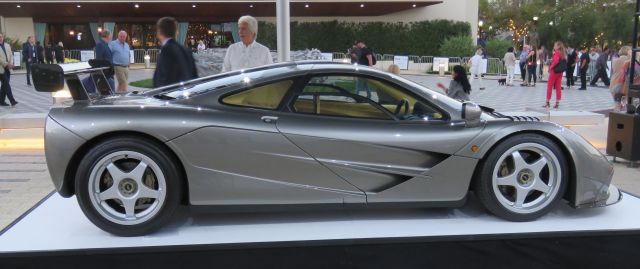
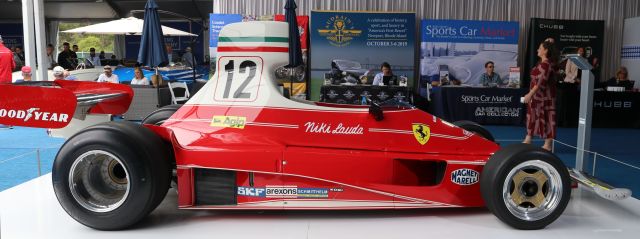 Apparently Gooding & Co. was a little optimistic about their 312T’s value in today’s market, and its hammer price of $5.45 million was more than a half million under their low estimate of $6.0 million.
Apparently Gooding & Co. was a little optimistic about their 312T’s value in today’s market, and its hammer price of $5.45 million was more than a half million under their low estimate of $6.0 million.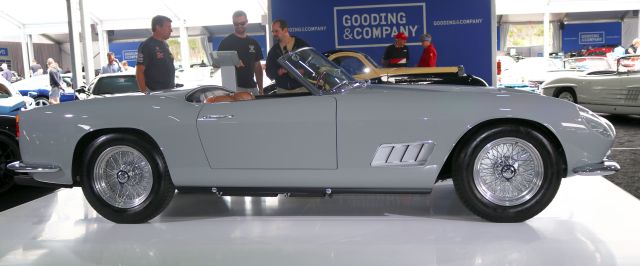

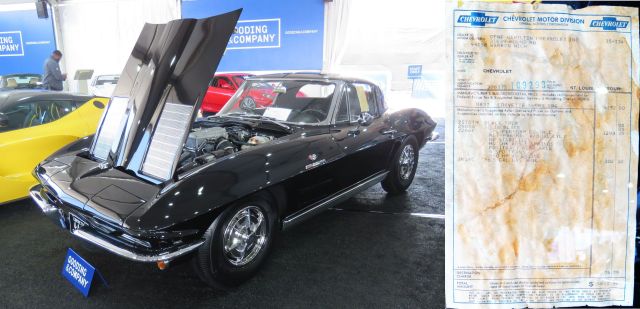 The sticker shows all the right pieces, but even with all that, and beautifully restored, Lot 48 only bid to $530,000, about 25% below the low estimate
The sticker shows all the right pieces, but even with all that, and beautifully restored, Lot 48 only bid to $530,000, about 25% below the low estimate



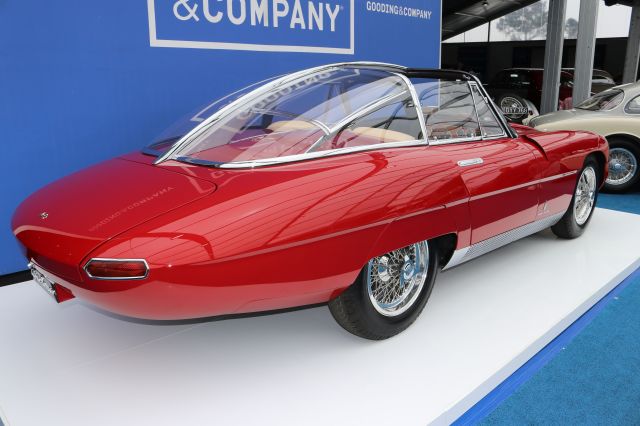











 Many (ourselves among them) consider Giorgetto Giugiaro to be the greatest of Italian car designers of the ‘sixties. One of his early designs while at Ghia is the original Maserati Ghibli. In absolutely flawless black over creamy Italian leather, Ron Corradini’s 1967 example, with its powerful 4.7 liter 4-cam dry-sump V8 was positively stunning. If you were wondering, this is not the model Joe Walsh claimed “does 185.”
Many (ourselves among them) consider Giorgetto Giugiaro to be the greatest of Italian car designers of the ‘sixties. One of his early designs while at Ghia is the original Maserati Ghibli. In absolutely flawless black over creamy Italian leather, Ron Corradini’s 1967 example, with its powerful 4.7 liter 4-cam dry-sump V8 was positively stunning. If you were wondering, this is not the model Joe Walsh claimed “does 185.”




















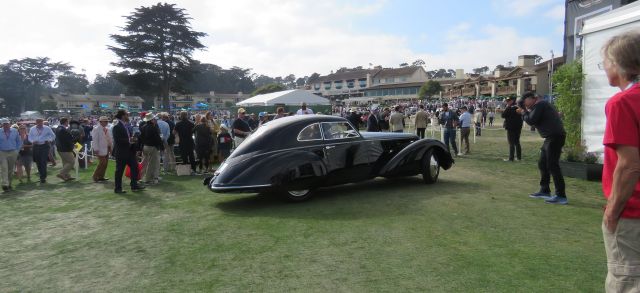

 The Alfa’s Touring Superleggera coachwork is a thin alloy skin supported by tiny metal tubes. Extreme front mid-engine layout places the mass of the engine behind the front wheel centerline for more even weight distribution.
The Alfa’s Touring Superleggera coachwork is a thin alloy skin supported by tiny metal tubes. Extreme front mid-engine layout places the mass of the engine behind the front wheel centerline for more even weight distribution. 











































































































Long Distance Heroes
Parker Subaru, Coeur D’Alene, Idaho
You can only pack so much into a Yelp review, but we had an experience finding a replacement for our daughter’s car lease return that deserves expansion. Briefly put, if you need a Subaru in Idaho, Parker in Coeur D’Alene (By now the spelling comes easier.) gave us service above and beyond all expectations.
No More Focuses
The community college system in the Los Angeles area offers a good opportunity for someone working part time to build a class portfolio without piling up student debt. The trouble is that you have to take classes where and when you can find them, at scattered campuses.
That drags out the process, and means a student needs a car. Your correspondent knows a thing or two about them, and has some contacts that prove useful from time to time, so our daughter has had a succession of Ford Focus sedans. One of them saved her life, sacrificing itself in a collision and calling 911 while she was briefly dazed.
One of those was subject to the transmission problems that plagued the model. She learned from that experience and that problem did not return. The last three have been leased, and my contacts at Galpin Ford in North Hills have always treated us well.
The Ford Focus is what the mainstream auto writers call a PGC – “Pretty Good Car.” But beware of stop-and-go-traffic uphill on hot days. If you stop, holding your position with the throttle, the dual-clutch automatic has a tendency to overheat and yell at you.
Education – Higher Yet
With two Associate degrees, our daughter was ready for a four-year college. The University of Idaho in Moscow, Idaho, accepted her as a virtual senior into their pre-vet program. One winter in that snow convinced her that when her lease was up in October, she would not be buying her leased Focus. All Subarus (other than the sports coupe) are all-wheel drive and our experience with Subies has been great, so with year-end deals it was a no-brainer.
The Search
All her cars had been leased in our name, so to establish credit, we agreed to co-sign on a new Subaru purchase. They make a sweet little crossover hatchback, the Crosstrek, but after learning what they sell for, we settled on an Impreza hatchback.
Our contacts here quickly had us finding a great deal on a local car at Pacific Subaru. Unfortunately, they can’t register a car in Idaho.
Among Idaho dealers, Brendan OReilly at Parker Subaru in Coeur D’Alene, shot to the top with his responsiveness and availability, answering texts after midnight on Sunday!
Doing a third party deal as co-signer by long distance from Los Angeles is no picnic. Just finding a particular car in a “small market” can be a challenge, but Brendan found a car in the pipeline – in Washington – and dealer-traded for it. His associate Devin coordinated the process and handled all the paperwork.
They needed wet signatures to get the car, so she drove her Focus to Coeur D’Alene in snow and rain to turn it in across the street at Mike White Ford.
After a delay across the street (They badgered her to buy a Ford!) she signed all the papers, and they gave her a loaner to drive until the new car arrived. That was Saturday. There was some confusion because they thought we’d be coming to Coeur D’Alene to co-sign, so they didn’t send the documents to us until Monday.
FedEx overnighted them, and we signed them Tuesday and shot them back. They arrived at Parker on Wednesday in time for Jason to drive the car to Moscow where our delighted daughter took delivery.
Delighted daughter, 2019 Subaru Impreza,
Now THAT, my friends, is service!